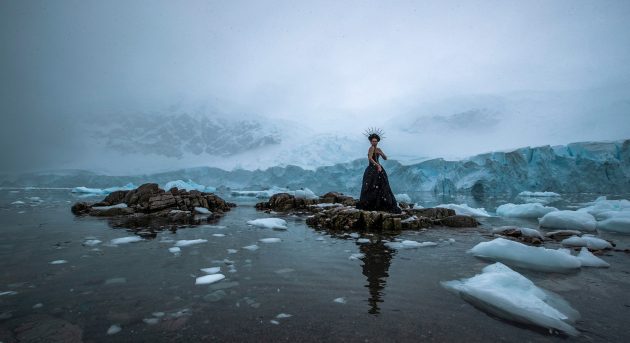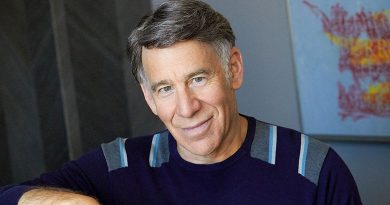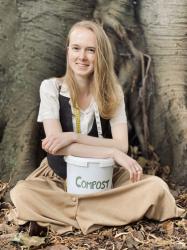The Composting Costumier talks Art Vs. Extinction with Moira Finucane
This interview took place between Wathaurong, Woirworung and Boon Wurrung Land. I acknowledge the Australian Aboriginal and Torres Strait Islander peoples as the first inhabitants and Traditional Custodians of the nation and pay my respects to their Elders past and present.
Recently I interviewed Moira Finucane about I Miss You Antarctica (Part of Finucane and Smith’s Art Vs. Extinction suite), streaming on September 5th as part of Melbourne Arts Centre’s Take Over! Digital Residency program.
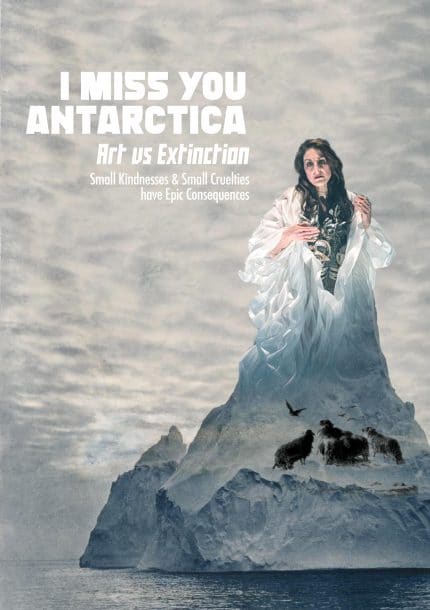
CC: Can you talk a bit about your artform
MF: My artform is complex and multifaceted. Growing up I had three loves – fairytales, the lives of saints and the natural world, and they’ve manifested in many different ways.
I studied environmental science, working in environmental law and World Heritage conservation for a number of years. That was a really big passion that continues now. Then I worked in human rights for a decade and international gender development, primarily on violence against women and girls, with incredible communities all over the world. Somewhere in all that I started performing in Melbourne’s underground club scene, which in the mid-90s was wildly political, eclectic, and totally exciting.
I started creating this performance style: a mashup of fairytales, archetypes, politics and great music, all put together with gaffer tape at 3am. Though my work is much bigger now, that beginning was “how do you capture people’s attention amidst the wild substances of a nightclub, alcohol, late nights, and a badly lit stage?” There’s no better training ground to take one wild idea and make it riveting.
CC: Was your move into performance art a pretty organic thing?
MF: Very organic. Lots of people in the arts say “I’ve worked in a coffee shop, or I’m a teacher, but I want to be an artist”, but for me, life’s not a segmented thing. You can be all of those things at once, in the foreground and background.
I’ve always been driven by this incredible desire to make a contribution. I have a passionate desire to see a more just, equitable, celebratory world, where the stories told are thrilling, representative stories of our community, not just a single part.
CC: Can you talk about your EPIC project, what inspired that and how you draw on it in now?
MF: In 2012 I went on this epic journey around Australia with a show which came from The Burlesque Hour, which I call “a discourse on human rights dressed up as a hot night out”. People always told me it wouldn’t work – “that it’s too risque, audiences and the country aren’t ready for it.”
In defiance of that, we created Caravan Burlesque. It mixed up the charm to alarm ratio a bit, and went all over Australia – from The Pilbara to the depths of Tasmania. In the middle, we ended up at Tennant Creek meeting incredible Indigenous artists and Community.
We travelled through the NT with the amazing Gurindji artist Kamahi Djordan King and during that, my eyes were opened to a part of Australia I’d never seen before. They loved our work so much in Tennant Creek a cabaret troupe formed called the Sunset Sessions and they urged us to come back. That started this deep relationship and EPIC was the kind of accelerant.
I wanted to go from the top of Australia, right down to our imagined South, Antarctica, to understand more about our country, cultures, healing and land.
I went from the Tiwi Islands, met incredible Indigenous artists and Communities on the Anangu Pitjantjatjara Yankunytjatjara (APY Lands), formed a really deep relationship with the community in Marlinja Country 700 kilometres south of Darwin and went to Antarctica. That fed The Rapture, my understanding of who I am as an Australian and my responsibilities.
CC: Have you still got a connection with the people you met along the way?
MF: Most of them. The Indigenous communities I visited, I had a connection with because someone said, “You should come to our Country, sit down with us and learn more about us.”
The connection with the Marlinja community, with Ray Dimakarri Dixon – a Mudburra man and a genius songwriter – flourished and blossomed into something really epic. When I first met Ray and his daughter Eleanor Nalyirrima Dixon at Tennant Creek, hearing them sing literally changed my life. They sat me down in a tiny school room, talked to each other in Mudburra, (a really poetic language only spoken by about 50 people now) and sang for me. As they sang, everything around turned black and expanded out, and then eventually came back in and resolved again. The song was the Goodbye Song, for people who’ve passed, about Country, and people waiting for you on the other side. It’s incredibly beautiful and incredibly sad. In that moment we began a relationship that continues five years later. I ended up producing Ray Dimakarri Dixon’s first solo album. He said, “I want you to help record my songs of Standing Strong, you’re the right person to do this.”
The album is very beautiful and became a finalist for Album of the Year at The National Indigenous Music Awards this year. Ray then came and collaborated in The Rapture and that continues. They asked us to be Artists in Residence on their Country and next year, Fincune and Smith will work with the Marlinja community to create their first Festival of Culture, Country and Healing.
So EPIC, supported by Creative Victoria, allowed this incredible journey and opened my eyes to become a better artist and Australian. By the time I finished, I’d seen sights and heard sounds that I’ll never forget and I was changed.
CC: The connections that you can make through art are incredible.
MF: I’ve always believed that art can change culture and lives. And I don’t come from an artistic background, so I really know that, because it happened for me.
When I was the inaugural fellow at the National Gallery of Victoria, I travelled all around the world and met lots of people who love art.
All of them, in lots of different languages, said that art takes them somewhere, and what’s more, the art they love doesn’t tell them where it’s taking them, but sure enough, they go on that journey.
I see that everyday, the power of opening people’s hearts, minds and visions to something new, exciting or deep within themselves they didn’t even know existed.
CC: You mentioned The Rapture. Is your Art Vs. Extinction project part of that? How are those connected?
Art Vs. Extinction is a provocation across The Rapture; I Miss You Antarctica and Shop of Hope. I met this incredible climate change and cultural activist in Cuba who said, “I want you to bring some work to Miami” for her Climate Change festival – Climakaze. So I went back to Australia and this provocation landed in my head – Art vs. Extinction. I loved it, the battle-ground feel that puts extinction right on the table as something we’re facing. The Rapture was the first thing that came out and was commissioned by a festival in Slovenia and by Climakaze. It’s become all these different, strange things. Art Vs. Extinction is like a giant octopus with many suckers and the capacity to move quickly from one thing to another.
It continues to evolve: I didn’t want The Rapture to be a single work but a lifetime pursuit. Art has this transformative power that can take you anywhere – The Rapture has never been seen in a traditional theatre, it’s taken me to all kinds of places: all over Australia, the Prague Quadrennial, a silent movie theatre in Berlin; a forest in Denmark; and a disused military site in Ljubljana, Slovenia. I don’t know whether I’m running it anymore or it’s running me.
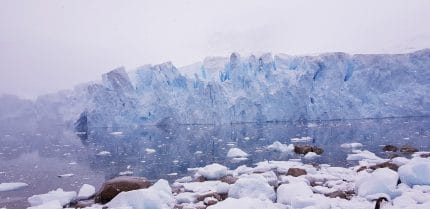
CC: Part of Art Vs. Extinction is I Miss You Antarctica, can you talk about that?
MF: Lots of people have strong feelings about Antarctica, but it’s the only land in the whole planet with no permanent history of human habitation – it’s unique – it exists almost in our imagination. There are stories of the “Heroic” age of Antarctica – with Scott and Shackleton and extraordinary legends from indigenous peoples that made it to a “great white land”. It swirls in so many people’s minds as this mythical place, full of glaciers and jade icebergs.
Ever since I was a kid, I wanted to go. And I did! Last year I went on the last voyage of this amazing Russian icebreaker and took a field recorder. I just looked and saw everything – the colours of Antarctica: whites, incredible greys, blues and blacks of the sea and sky, really dark rock, no trees, no greenery, rusty reds that course through it. All the birds, animals and sea creatures are part of this incredible palette. I interviewed scientists, expedition leaders and people who were going on the trip of a lifetime too. I spent hours just standing in the snow, looking at penguins and recording.
When I came back, it’s like it runs in my veins. I Miss You Antarctica, is about grieving things we’ve never beheld because most extinction is not witnessed. The melting of the glaciers and mass mortality events of species, mostly we don’t witness. It’s a poetic work about missing things we’ve never seen and yet knowing how precious they are.
It’s a funny time to do a work like this, we’re all missing each other and things that maybe we took for granted and the creation has woven in a really intent way.
It’s a poetic fairytale: not just a list of all the things that we’ve lost, but a story about the power of a vision of hope. In fairytales, small kindnesses and small cruelties have epic consequences and I Miss You Antarctica is about that and about truth.
CC: You work with the group 15 Trees, to plant one tree for each table sold at your performances. How did that begin?
MF: The founder of 15 Trees, Colleen Filippa, is a scientist, who went to Antarctica and loves it as I do. I took a picture of a really beautiful tree on my EPIC journey through Australia and posted it to Instagram. 15 Trees saw it and said “We love your tree, if you let us use this picture we’ll plant a tree for you.”
What I’m seeking ever more urgently is, when people come to see a Finucane and Smith Show, not only are their hearts opened to have a visceral exchange about the world, I want to turbocharge that. So you know by coming things will change – you will change and things will get better.
After The Rapture, I handed out a “Roadmap of Hope”. People talked furiously at the end about that and sent me things – “this is what I think is hopeful”. What happened was like a weather-pattern of hope. “What makes you feel powerful enough to turn back despair and do something to make the community you want to live in?”
One of the things I want to resist is that sense of despair. Hopelessness isn’t just a byproduct of oppression, it’s a tool: if people are taught their voices won’t be heard, they’re less likely to speak up. What I want is to raise up the possibility of hope, make it an action that is tangible. A hopeful community is a very powerful one.
CC: What gives you hope for the future?
MF: People ask “what’s the best thing we can do to change the world?” And I think any contribution to the community is transferable. If you’re kind – a kinder community is powerful because it’s more cohesive, more able to stand up for itself. If you find a practical contribution to make to justice for First Nations peoples it will make everyone’s life better. Looking ahead, I feel like I don’t have an answer, if I just keep making some contribution, things will keep moving forward.
CC: How do you maintain awareness around the resource use that goes into creating your work?
MF: There are two answers and in a way, they’re in direct contradiction. As an artist, I’ve travelled extensively around the world and that’s a negative contribution to sustainability. I’m questioning that more.
But in our work, we don’t tend to waste anything and that’s not just an environmental decision. It’s how we value what we have:
The overview is not so much our green footprint, but about how we treat the artists and the artefacts that make up our work. I’ve identified that as Gesamtkunstwerk – a German word, which means “Total Work of Art”.
If you have an exhibition of 20 beautiful, Impressionist paintings, you don’t just throw them all out and start again next time. Everything we use is a Gesamtkunstwerk: handmade, bespoke, beautiful works of art by beautiful artists, that we keep, use, reuse and reimagine. We invest in our artists, grow relationships and nurture them. They go off for a year or two, do amazing work and then come home to us, like swallows, which is why we have two swallows in our logo. Almost all of them have voices that are lesser heard in the dominant culture. So, that’s how I see sustainability. It’s about art, work and valuing artefacts and the people that make them.
When I go to a festival, I’ve been thinking of ways to partner with them so our coming is a provocation to make a stronger connection to community. A presenter in Denmark came to The Rapture, found out about 15 Trees and thought “this is such a good idea – you [perform], we make the partnership and trees go in the ground.” My mind opened and I realised that could be a global theme. Every time a Finucane and Smith work goes somewhere, something grows. Wouldn’t that be amazing‽
Can I ask you, what you think about artists travelling? About plane travel?
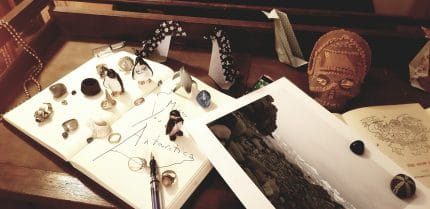
CC: That’s a common concern in pretty much every interview I’ve done – I ask “What’s your biggest challenge?” and everyone says travel.
I don’t have an answer myself, but it would be interesting as an industry-wide community to find an answer. Whether it’s more global teamwork that’s spread across countries, or as an industry, figuring out some way of offsetting? (That’s kind of dealing with the issue after the fact.) It’s definitely something affecting everybody.
MF: I love travelling, immersing myself in different cultural contexts, cross-cultural collaboration. But one of the things being talked about a lot is don’t travel for conferences. Travel to do the work, but don’t just fly to Australia for the Performing Arts Market. I know a number of colleagues who say we need to share in different ways, not travel all over the world just to program work.
CC: It’ll be interesting to see what comes out of COVID, now everyone’s more used to doing stuff digitally.
MF: That could be really exciting. I spent a month on the Tibetan plateau working with the Ching Hai acrobatic troupe, it was so exciting and there’s no replacement for that – I needed to be there to work at a human pace through cultural exchange. But I could easily collaborate with people on my team from a different country. So long as you’re on the same page you can do that remotely.
CC: It’s all about establishing that human connection.
MF: That’s part of sustainability as well – cherishing people and your audience. Live theatre is about an audience, they’re my greatest partner in adventure. Our audiences have come with us into all kinds of spaces- they started off in a wild, raucous milk-spraying burlesque night and now they’re on the edge of their seats having a think about Antarctica, that’s really beautiful.
CC: And that’s really the point: to help people grow.
MF: People have diverse taste buds, they are capable of so much.
One of the things core to my practice is I expect a lot from my audience. I expect that they are smart, curious and have an infinite capacity to grow. I’ve never been let down.
My work, even though it’s politically complex, and rich and dense like Christmas pudding, it never lectures.
CC: As the Composting Costumier I have to ask about your compost.
MF: I have two active worm farms, the worms are happy and very numerous. I’m fully on the composting front, although I would like to encourage everybody to have one native plant in their garden, even if you’ve only got pots on your balcony. Go to the nursery and ask for one native flowering plant and local birds, local bees will fall in love with you.
CC: That goes back to valuing the role of different things in the world, like the flow-on effect of planting one native on the ecosystem.
Some people change the world through the course of their life – those are extraordinary people. And some change it in little ways with flow-on benefits. I think for most people and I include myself, the idea of tackling everything is too overwhelming. So sometimes, just do something little.
Grow your courage: plant one native tree; next time you see an injustice write one letter; when you’re worried about changing the date for Australia Day, or how terrible the number of Indigenous deaths in custody is, find an Indigenous-led organisation and make a contribution. Take that one step and the next steps are easier, and even if not, they’re worth it.
CC: What other actions do you take in your life to make a contribution?
MF: Like everyone else, I lean towards things I feel most passionate or knowledgeable about. I try to make a regular contribution to ending gender violence and fostering respectful relationships in our community through all kinds of things, mostly voluntary. I try to contribute to making Australia a better place – when people say in the Acknowledgement of Country, we show respect to Elders past, present and emerging, I try to show that actively – when I can, I contribute financially to Indigenous-led organisations that lift up Indigenous voices and work for justice. I try to lift up Indigenous voices in my context with the power I have as someone who’s been in theatre for a while.
And I try to be kinder than I feel, that’s one of my mantras.
CC: Do you have any groups or you’d recommend making a contribution to?
MF: There’s an outfit called Djirra, they’re an amazing Indigenous-led Organisation that aims to end family violence. They’re statewide in Victoria, led by a really powerful woman, and work with Aboriginal women throughout Victoria.
To find out more and make a contribution go to djirra.org.au

